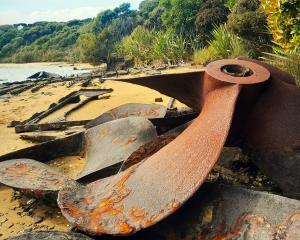
Crystallisation is a transition from chaos to perfection; the evolution of the crystal industry has been less simple. Millions of years ago liquid rock inside the earth cooled and hardened, and this is how crystals formed at the twinkling centre of the earth. Piece by piece they've been mined to become the centre, too, of an international industry that hangs on their rumoured metaphysical healing properties. But recently something else has emerged from the rocks - a darker truth. Rather than connecting with the earth, those buying crystals are damaging it, fatally.
In three short years, crystals have risen from niche new age interest to valid hobby, firmly embedded in the mainstream consciousness. In 2017 crystals became a multibillion-dollar slice of the $US4.2trillion ($NZ6.43trillion) global wellness industry, with shamans using them to advise entrepreneurs on investment opportunities, and Gwyneth Paltrow selling them to encourage serenity and to "purify" water. Their investment status is compared to fine art. Women have been persuaded to welcome their presence in beauty products and fashion accessories, not by spiritual healers, but celebrities.
At a New York Fashion Week presentation, Mary-Kate and Ashley Olsen gave guests "black tourmaline to keep negative energies at bay", and "white clear quartz to promote harmony and balance". Kate Hudson "adds a little energy" to her moisturiser by storing it beside crystals; Adele blamed a bad performance at the Grammys on the fact she'd lost hers; and Kim Kardashian used them to recover from the stress of a robbery.
When Jennifer Lawrence moved into her new home there were crystals embedded in the walls. "The house was crystalled out," she told Vogue, but she didn't want visitors to think she was a "crystal person". She was advised not to treat them casually, to employ the official "crystal lady" that had installed them to remove them, too, but of course she scoffed, and got a builder to rip them out. "I just had all the crystals yanked out. Sold them," she said, before adding, pointedly, "And then my f****** house flooded." Today, even those who don't identify as "crystal people" have been persuaded of their power.
But while it's claimed crystals help people harness the energy of the earth, the more they are mined, the more that earth is suffering. Here is the dirty truth of crystals, and it's not simply that their efficacy as healing objects is unproven. It's that, as Emily Atkin at The New Republic reported last year, their origins are murky, and their environmental impact worrying. Much like diamonds, crystal mining is an industry buried in conflict. There are issues around sustainability: crystals are a non-renewable resource. There are issues around labour: most jobs are low paid, unsafe and sometimes performed by underage workers. And there is an issue around accountability: the industry is unregulated, allowing exploitation to go unchecked.
"Mining has an environmental impact, whether it's for `healing crystals', the copper in your phone, or the gold in your ring," Payal Sampat of nonprofit organisation Earthworks explains. The quote marks are her own. "`Healing crystals' are mined in places like Myanmar and the Democratic Republic of Congo, where mineral extraction is linked to severe human-rights violations and environmental harm."

"As with most minerals," Sampat adds, "it is impossible to know for sure if your crystal was obtained via an environmental and human rights horror show."
Crystals are found on every continent, but it's difficult to find a crystal seller who will specify the origins of individual stones and even harder to find one willing to talk honestly about the effects of mining. There's no governing body requiring they do so, no regulator for an industry mired in exploitation and secrecy. Stephen Wells at Kacha Stones is one of a handful of sellers who pride themselves on their ethical practices. He emails from India, where he's sourcing moonstone, tourmaline and kyanite despite their rarity and his infected root canal. "If something is cheap and available in huge quantities," he writes, "the odds are it's the result of a huge commercial enterprise, often the by-product of mining entirely unrelated to crystals."
For Wells, the importance of ethical crystal mining is not solely about the impact on the planet, but also on the crystal itself - he believes the mining of a stone affects its healing properties.
"Taking something by force, destructively, has an effect on any living thing. Crystals are archetypal pure frequencies, nature's perfect geometric tuning forks. Can anyone imagine the shockwaves of explosions having no impact?"
At home, using a garden fork and trowel, he digs for Welsh quartz.
"I don't dig indiscriminately. I fill in the small holes I make and try not to exploit myself in the process. That's as eco-friendly as mining gets, but it isn't going to make much of an impact on global trade."
The more we talk, the more surprising it seems that crystal consumers, the kind of people who wouldn't eat a battery-farmed egg, let alone meat they couldn't trace, are yet to question the provenance of their crystals.
In an industrial park in Watford rain beats down on the plastic roof of the warehouse where The Crystal Geode, a wholesale crystal supplier, stores its salt lamps, amethysts and complicated fairy ephemera. Neil Ashcroft, director of the family business, explains first the expansion of the company, and then the expansion of his mind.
In 1986, when he was in his late 20s and working for the police, Ashcroft was in a motorbike accident that put him in hospital for two years. It technically killed him three times and lost him his left leg. He had "out-of-body experiences"; when he finally returned home, he was different. An ex introduced him to crystals, which helped him feel more "grounded". He never planned to make much money from selling them and still, today, spends much of his time advising customers on, "say, which stones are best for anxiety, or which are best for blood disorders".
But as celebrities began broadcasting their interest, Ashcroft says, he saw the industry explode. While sales are up, the pressure to undercut prices online is rising too, which makes it harder for Ashcroft to maintain his insistence on high-quality crystals, ethically mined. And while he attempts to work only with suppliers he trusts, he's clear there's much he'll never know: crystals are rarely the primary product that miners are looking for, but rather the shiny byproducts found alongside more valuable elements used in our phones and TVs - so mining supply chains are complicated and often shrouded in mystery.
Ashcroft releases a defeated sigh: "All I can do is ensure that at least quality and genuine crystals are coming into the market. We're buying from the best possible sources. But sometimes unethical mines are the only sources of the crystals people want. I try to stay as aware of their origins as possible, but I can be concerned about it while also feeling ... impotent?" He shakes his head. "Most retailers feel they want to [be ethical], but can't implement it."
As we descend from the office into aisles lined with cardboard boxes containing carved angels and jade tumble stones, he tries to elaborate - the market is so huge, the demand is so high, the internet is so vast ... But his words tail off.
The truth is, many retailers have no idea where their crystals come from. Many, like tourmaline, amethyst, quartz and citrine (used to "manifest abundance and prosperity") are found in gold, copper or cobalt mines, but even publicly traded industrial mines aren't required to disclose profits from byproducts. And rather than directly from mines, or even the factories where the stones are cut and polished, retailers like The Crystal Geode buy from go-betweens, independent traders who sell at touring shows, who, even if they have documentation to prove their supply chain, are disinclined to share it, in part for fear of doing themselves out of a job.
The experience of taking a train into the suburbs, then driving through an industrial park, then picking through the boxes of a crystal retailer felt like an odd reflection of the experience of trying to understand the dark origins of crystals themselves: a step-by-step sloughing off of glamour, of magic. Their story is not dissimilar to that of cocaine, a drug that wealthy westerners buy because it makes them feel fun and interesting, choosing to ignore the fact people have almost definitely been tortured and beheaded earlier in its supply chain in order to provide their weekend buzz.
Consumers buy a product they benefit from, whether through the brief bitter high of cocaine, or the compliments garnered from a cheap party dress, or the feeling of inner peace from wearing a crystal, and therefore, doesn't it make sense that we share in the moral culpability for the unethical practices that brought it to us?
In Notting Hill, it's easier to forget. The Financial Times' "How To Spend It" profile of the owners of Venusrox begins with a vision of wealthy wellness: "Matt and Victoria Forster are smooth-skinned, clear-eyed and radiate a happiness and harmony that most of us could spend a lifetime failing to achieve. Ask them their secret and they answer in unison: `Passion for crystals'."
One bright morning (after they twice turned down interview requests), I visited their showroom, a gallery of stones all of which are labelled with the country they've come from, and some also labelled with the mines. There were small smooth stones (including lapis lazuli from Afghanistan and shattuckite from the DRC) for a few pounds, and large glittering rocks the size of a newborn baby for tens of thousands. It was here that the secondary ethical dilemma of the crystal industry became immediately apparent. It's one thing to market a crystal for its decorative purposes, but another with the promise it will, like amethyst, "help overcome addictions".
The appeal of crystals is two-tiered. Their infinite sparkliness has an obvious draw, but their value relies on a belief in their healing powers. Emma Lucy Knowles, author of The Power of Crystal Healing (her celebrity clients include Victoria Beckham), explains it to me like this: "We work with crystals to draw out the `negative' and `heighten' the positive, such as love, protection, abundance or seeking to detoxify from fear, guilt, worry. They can be used to filter that property into the energy centres, the chakras." She recommends placing quartz beside photos of people you love, "to promote that vibration in their direction". "Crystals are formed under pressure, much like ourselves. The power of life force - what's not to love about that?"
It's a hypothetical question.
Standing among the quartz and citrine in Notting Hill, I breathe deeply, and consider my flow. In 2001 Dr Christopher French, a psychologist at Goldsmith, set out to test the effects of crystals on 80 volunteers. Half were given a piece of quartz to meditate with, while the rest were given a piece of similar-looking plastic and told it was a crystal. They were also given a booklet explaining 10 of the sensations they might experience, which included tingling, more focused attention, improved sense of wellbeing, a rise in hand temperature and "activation of all levels of consciousness".
Out of the 80, only six failed to experience at least one of these sensations.
"The fact that the same effects were found with both genuine and fake crystals undermines any claims that crystals have the mysterious powers which they are claimed to have," French said.
Dr Richard Wiseman, a psychologist at the University of Hertfordshire in Hatfield, added: "The power of crystals is in the mind instead of in the crystals. Clearly there is an effect, but people are paying hundreds of pounds for crystals and they might as well pay just a couple of quid."
But who really wants to hear this? Who wants to pull back the wizard's curtain?
Neil Ashcroft of The Crystal Geode is clear that crystals have helped him: "They work - whether it's a placebo effect or not, they worked for me."
For most of his customers a belief in the healing power of crystals, rather than the power of placebos, is a kind of faith. An understandable choice, it could be argued, in a time when people report feeling ever more critical of experts and "facts", keen for a release from technology, disconnected from traditional systems of care and desperate for something shiny that might save them. While it might be possible to debate the efficacy of healing crystals, it is harder to argue the often murky ethics of the process that delivers them.
As the crystal market continues to grow, so does the need for an international reckoning. In 2000 campaigning from organisations such as Global Witness resulted in a United Nations resolution, and the establishment of the Kimberley Process in 2002 virtually eliminated "conflict diamonds". It's possible that similar regulations could be introduced for crystals, but it's unlikely at present - despite the celebrity-led boom, the healing crystal industry is still nowhere near as profitable or powerful as the diamond industry. A crystal revolution would rely on a tipping of emotion. A consumer push.
"It would be a great shame," says Sophia Pickles, the campaign leader at Global Witness, "if consumers buying goods that they believe help them `connect with the earth' are, in fact, making purchases that are connected to grave human-rights abuses, environmental destruction, conflict and corruption. Unfortunately, this is a very real risk for products like crystals."
Until retailers are required to prove responsible sourcing and reveal their supply chains, she says, crystal consumers must acknowledge they're participating in practices that are having devastating environmental and social impact.
"The responsibility of companies to address harms to people and planet in their supply chains is gaining increasing traction. Industries selling `wellbeing' that do not make it their business to take steps to ensure they are sourcing their materials responsibly are at risk of accusations of deep hypocrisy."
A slow change is rumbling. A petition demanding Paltrow's Goop sell only ethically sourced crystals runs at almost 17,000 names, under the line, "No amount of sage can get rid of the bad vibes that come from human exploitation and environmental destruction".
The growing number of people who use crystals, whether to "detoxify", reduce anxiety, or decorate iPhones, must acknowledge their healing crystals are likely to have contributed to human trauma or environmental destruction.
If more people knew this, wouldn't they begin rocking the boat? Campaigning as we have with food and fashion, people could start asking questions, demanding transparency about a crystal's origins, about the conditions of the mine, and the route it took to arrive in their warming hand. Because the power of a healing crystal is nothing compared with the power of a hundred thousand crystal buyers closing their purses.
- Guardian News and Media
Comments
New Age Capitalists.
Tell the shamans, if they can stop singing and impersonating wildlife.
In the old days, you could tie a strap to the bumper, dragging along the road, to ward off carsickness.











